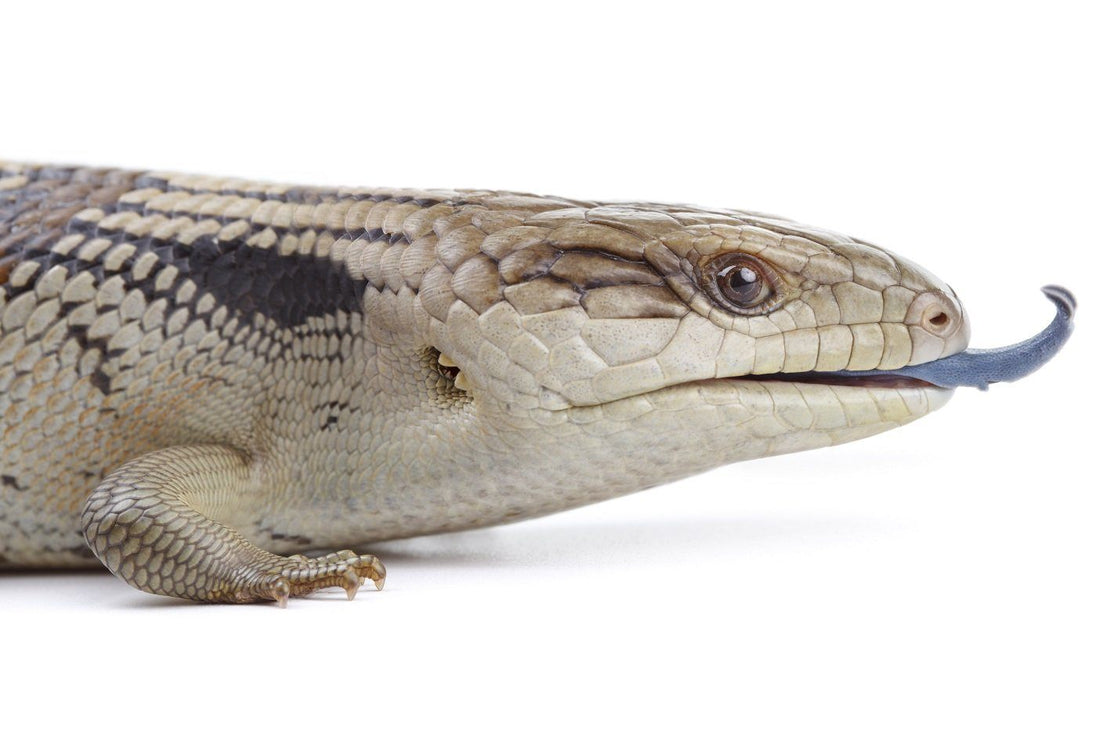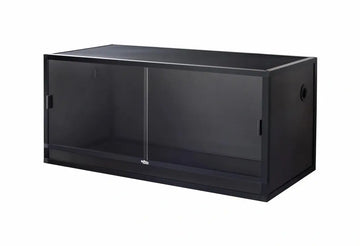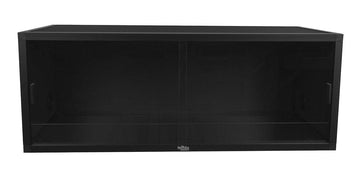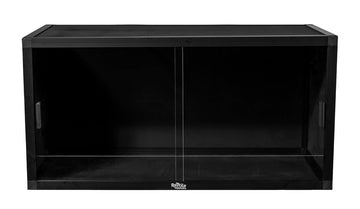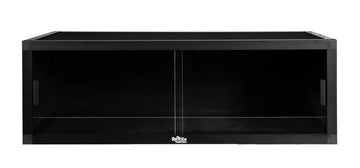Table of Contents
Introduction
Blue tongue skinks (Tiliqua spp.) are 18-24” long, diurnal lizards native to Australia and Indonesia. Depending on species, they can be found in scrublands, grasslands, mediterranean and temperate forests, tropical rainforests, and even deserts. There are 12 recognized species and subspecies, all but one of which being available to the pet trade.
Blue tongue skinks are stout, sturdy lizards with an elongated triangular head, a medium-length tail, and short, strong limbs with short digits. Pattern and coloration can vary widely from species to species.
Blue tongue skinks generally make good pets due to their hardiness and personable temperaments. In fact, they’re one of the most popular pet lizards in the US. With good care, a pet blue tongue skink can live 20-30+ years.
How to identify different types of blue tongue skinks:
Knowing which type of blue tongue skink you have is important to knowing how to care for them.
Australian
- Blotched (Tiliqua nigrolutea): Found around the southeastern tip of Australia and Tasmania. Preferred habitat is sclerophyll forest, montane woodland, and coastal heath. Identifiable by a black base color with yellow/orange/red blotches, and mottled limbs.
- Centralian (Tiliqua multifasciata): Found around northwestern, northern, and central Australia. Preferred habitat is stony hills and sandy desert. Identifiable by a light base color with yellow/orange/red/brown banding down the body and large black markings behind each eye. Tail is short.
- Eastern (Tiliqua scincoides scincoides): Found around southeastern and eastern Australia. Preferred habitat includes coastal heath, forest, woodland, and grassland. Identifiable by a gray to brown base color, dark banding, patternless limbs, and dark markings behind each eye.
- Northern (Tiliqua scincoides intermedia): Found around northern Australia. Preferred habitat includes coastal heath, forest, and grassland. Identifiable by a gray to tan base color, with darker banding, yellow/orange blotches along the sides, patternless limbs, and no dark marking behind the eyes.
- Pygmy (Tiliqua adelaidensis): Found around Mt. Lofty in South Australia. Preferred habitat is grassland, often occupying spider burrows. Identifiable by a gray to tan base color with darker spotting or blotching. More slender in build than other blue tongue skinks, with a short tail. Not found in the pet trade due to endangered status.
- Shingleback (Tiliqua rugosa): Found around southeastern, southern, and western Australia. Preferred habitat is coastal heath, dry sclerophyll forest, shrubland, plains, and sandy desert. Identifiable by bumpy scale texture, dark tongue, and short plump tail.
- Western (Tiliqua occipitalis): Found around southern and western Australia. Preferred habitat is stony hills and sandy desert. Identifiable by a tan base color, large black markings behind each eye, and thick dark bands down the body and tail. Body is especially stout, with a short tail.
Indonesian
- Classic Indonesian (Tiliqua gigas gigas): Found on Papua New Guinea and surrounding islands. Preferred habitat is tropical forest. Identifiable by earthy yellow-green color with thin dark markings on the head, narrow dark bands and speckling on the body and tail. Limbs are dark and solid-colored.
- Halmahera (Tiliqua gigas gigas ‘Halmahera’): Found on Halmahera Island in Indonesia. Preferred habitat is tropical forest. Identifiable by reddish-brown color interrupted by black banding. Limbs solid in color, with thin black markings on the head. Belly is patterned.
- Irian Jaya (Tiliqua sp.): Found around Western New Guinea. Preferred habitat is tropical forest. Appearance is highly variable, but they generally have a brownish base color with brown, auburn, orange, or gray banding.
- Kei Island (Tiliqua gigas keyensis): Found on the Kei Islands of Indonesia. Preferred habitat is tropical forest. Identifiable by the freckled pattern all over their body.
- Merauke (Tiliqua gigas evanescens): Found around Merauke, New Guinea. Preferred habitat is tropical forest. Identifiable by gray or tan base color with darker banding, and a patternless salmon-colored belly.
- Tanimbar (Tiliqua scincoides chimaera): Found around Tanimbar Island, Indonesia. Preferred habitat is tropical forest. Identifiable by gray to yellow base color, darker banding, patternless legs and head, and shiny scales.
Enclosure
Minimum terrarium size for blue tongue skinks:
The minimum terrarium size suggested for a blue tongue skink is 48”L x 24”W x 24”H. Of course, these are fairly large, active lizards, so larger is always better — if you provide, they will absolutely use it! If you have the space a 5x2x2 would be ideal!
Can you keep two blue tongue skinks together?
Do not house multiple blue tongue skinks in the same terrarium. Blueys are territorial, and keeping them in the same space is likely to result in fighting and injuries.
How to quarantine a blue tongue skink
Note that it’s best to quarantine your new blue tongue skink first. Whether your pet is wild-caught or captive bred, quarantine is still important. Quarantine is the practice of keeping an animal isolated and under sterile conditions in order to reduce the potential spread of disease.
Even if you don’t have other reptiles that could potentially get infected by anything the skink might be carrying, maintaining quarantine conditions for the first 3-6 months will enable you to more easily monitor for concerning symptoms and more easily treat them as well. You can do this with the same enclosure that you plan to keep the skink in long-term, or you can do this with a tall tub. As long as it is set up appropriately, a large tub can make appropriate short-term quarantine housing. During this quarantine period it is recommended that you use a substrate like paper towel or shelf liner - something that can easily be cleaned and kept sterile.
Some rules for successful blue tongue skink quarantine:
- Keep the skink in a separate room from other reptiles.
- Do not use the same equipment for the new skink as for your other reptiles.
- Fully disinfect the enclosure weekly.
- Get the skink checked by an experienced reptile veterinarian and treated for parasites if needed.
- Observe for symptoms of disease or illness.
A blue tongue skink should be completely healthy before being transferred out of quarantine to its long-term setup.
Lighting
Do blue tongue skinks need UVB?
Technically blue tongue skinks can survive without UVB, but they are healthier when it is provided. UVB lighting helps provide a clear day/night cycle, provides all of the vitamin D that your pet needs, strengthens the immune system, facilitates better digestion, and other benefits.
The best UVB kit for blue tongue skinks in a 48x24x24 enclosure is:
Position the lamp on the same side of the terrarium as the heat lamp. If the lamp is positioned over mesh, the basking area should be placed 7-11” below for best results. If the lamp is mounted inside the enclosure, the basking area should be placed 12-18” below instead.
UVB is blocked by glass and plastic, so placing the terrarium in front of a window doesn’t count as “free UVB” — in fact it can make your terrarium too hot due to the greenhouse effect. Don’t forget to replace your bulb every 12 months or as needed if you have a Solarmeter!
How to measure UVI
The strength of a lamp’s UVB output is measured in UV Index, or UVI. Coincidentally, this is the same measurement that the World Health Organization uses to measure risk of skin damage from exposure to solar radiation. Fortunately, you don’t have to worry about your bluey getting skin cancer as long as you use UVB correctly. The best way to measure UVI in your pet’s enclosure is with a Solarmeter 6.5.
To use the Solarmeter, hold the device vertically at the height of the basking surface, with the lens pointing directly up at the lamp. Blue tongue skinks should have a basking UVI between 3.0-4.0, with UVI everywhere else in the enclosure being lower. Although there is a basking distance recommended in the previous section, note that factors such as the density of your terrarium mesh as well as the exact hood you’re using for your UVB lamp will affect the exact distance needed.
Other lighting requirements
As diurnal lizards, blue tongue skinks need more illumination than what they get from just a UVB lamp. To better simulate the brightness of sunlight, it’s best practice to also install a ~6500K LED or T5 HO fluorescent lamp to span most of the enclosure’s length. A great option would be the Arcadia Jungle Dawn.
Heating
Best temperature for blue tongue skinks:
Different species of blue tongue skinks have different temperature preferences: Northern/Eastern blue tongue skinks should have a basking surface temperature of 90-95°F, and Indonesian blue tongue skinks should have a basking surface temperature of 100-105°F. For both, the cool side temperature should stay between 70-80°F, and heat sources should be turned off at night.
Best way to heat your blue tongue skink
There are many options for heating a blue tongue skink enclosure: incandescent bulbs, halogen bulbs, red bulbs, blue bulbs, mercury vapor bulbs, ceramic heat emitters, etc. Which one is best for your pet? Does it matter?
It does, in fact.
According to experts, the best way to heat a reptile is with technology that most closely replicates the way the sun provides heat: halogen flood bulbs. Provide heat for your blue tongue skink with two halogen flood heat bulbs placed close together. A great fixture for the two halogen flood heat bulbs is the Zoo Med Combo Deep Dome. Avoid using other options, as these are less effective at providing basking heat and may negatively affect your pet’s health.
For best results, use a large flat stone (ex: flagstone, paver stone, slate tile) as the basking surface.
How to measure terrarium temperature
Measure temperatures with a couple of digital probe thermometers. One probe should be placed on the basking surface, and the other probe should be placed on the cool side of the enclosure. With the readouts from both of these devices, you will be able to monitor your pet’s temperature gradient at a glance.
If you notice that your basking temperatures are too warm, dial down the bulbs’ heat output with a rheostat. If they are too cool, you will need higher-wattage bulbs or will need to raise the basking surface.
Humidity
Best humidity levels for blue tongue skinks:
Humidity is one of the biggest differences between caring for a Northern/Eastern blue tongue skink and caring for an Indonesian blue tongue skink.
- Northern and Eastern blue tongue skinks need average humidity levels between 40-60%.
- Indonesian blue tongue skinks generally need average humidity levels between 60-80%.
- Halmahera Indonesian blue tongue skinks need average humidity levels between 80-100%.
Measure the average humidity in your blue tongue skink’s enclosure with a digital probe hygrometer, with the probe placed in the middle of the terrarium. Regardless of what type of skink you have, it’s best practice to install a humid hide in the middle to cool zone of the enclosure.
How to manage humidity for Indonesian blue tongue skinks
Increase humidity by misting your skink’s enclosure 1-2x/day with a spray bottle. It is recommend that you mist first thing in the morning and then again at night if needed. If you have a busy schedule, you may want to consider installing an automatic misting system. Mixing water directly into the substrate also helps with maintaining humidity.
Because humidity levels naturally rise at night, you may also want to consider installing a reptile humidifier. So you don’t accidentally saturate the enclosure, connect the fogger to a humidistat to regulate the fogger’s use.
Don’t reduce the amount of ventilation in your enclosure as an effort to reduce humidity fluctuation. Ventilation is key to helping your blue tongue skink stay healthy, and reducing air flow increases pathogen concentration. It’s okay to let the enclosure dry out a bit during the day!
How to set up a humid hide
In addition to a warm hide, your skink should also have a humid hide available in the middle to cool end of the enclosure. This hide functions like a humid burrow to which your pet can retreat when they feel the need for a bit of extra moisture. Having access to a humid hide is essential to maintaining a well-hydrated blue tongue skink that consistently sheds well.
Blue tongue skinks are generally too big for commercially-available humid hides, so you’ll likely have to make your own. These products are fully-enclosed and easy to clean. To DIY your own humid hide, use an upside-down plastic storage tub with a hole cut out for an entrance. Line the hide with moistened paper towel or sphagnum moss. Paper towel must be replaced every 1-3 days to stay clean, while sphagnum moss must be replaced every 2-4 weeks.
Do Australian blue tongue skinks get respiratory infections from humidity?
Northern and Eastern blue tongue skinks are widespread across the continent, and quite adaptable. Even when their habitat seems dry, they still like to hang out in humid microclimates, and they survive natural spikes in humidity like rainstorms just fine.
The truth is that respiratory infections are caused by consistently wet conditions, poor hygiene, poor ventilation, and/or low temperatures. This is because these conditions weaken a blue tongue skink’s immune system and encourage pathogen growth within the enclosure.
Substrate
Best substrate for blue tongue skinks:
“Loose” substrates that mimic a reptile’s natural environment present a low impaction risk, cushion the animal’s joints, and offer a place where they can exercise natural burrowing behaviors. These substrates also help maintain correct humidity levels.
We recommend the following substrates for blue tongue skinks. These substrates are versatile and can be used slightly dampened for temperate conditions or fully moistened for tropical conditions.
- Zoo Med Eco Earth
- Zoo Med Repti Soil
- Exo Terra Plantation Soil
- Zilla Jungle Mix
Layering clean, chemical-free leaf litter on top of the substrate is a good way to help increase humidity, and also provides a source of enrichment!
Substrate should be at least 4” deep and completely replaced every 3-4 months. Remove poop and urates daily, along with contaminated substrate.
What to know about cleaning a blue tongue skink enclosure
Replacing your blue tongue skink’s substrate is a good time to give the entire enclosure a good cleanout. Here are some general steps to follow:
- Remove your skink from the enclosure and put it inside a temporary, escape-proof holding container.
- Remove all substrate and décor.
- Vacuum and wipe down the enclosure to remove leftover particles.
- Apply a reptile-safe disinfectant such as Zoo Med Wipe Out to the floor and walls of the enclosure and let sit for the disinfectant’s recommended contact time.
- Meanwhile, soak branches, rocks, hides, and other decor in a disinfectant rated for porous materials for the recommended contact time.
- If required, rinse the enclosure and the accessories with clean water to remove disinfectant residue. Allow everything to dry.
- Pour new substrate into the enclosure. Mix in water until uniformly moistened but not wet.
- Arrange décor.
- Reintroduce your skink to the clean setup.
Some veterinary-grade disinfectant options that work for both porous and nonporous materials are F10SC, CleanBreak, and bleach solution. However, for porous materials, bleach solution should be in a 1:10 dilution, while you should use 1:50 for nonporous.
Can bioactive work for blue tongue skinks?
Absolutely. Bioactive vivariums can be a good choice of housing for blue tongue skinks because they are better at maintaining appropriate humidity levels and are generally more attractive than other options, which is especially nice if your skink likes to hide most of the time. Bioactive vivariums have the additional benefit of eliminating the need for total cleanouts, and a healthy vivarium always has a fresh, earthy aroma.
Some downsides of bioactive for blue tongue skinks are that they require at least one month to get established before the animal is introduced, the plants that you use need to be sturdy enough not to get crushed, and bioactive is usually more expensive to set up in the short-term. CUC (Clean Up Crew) organisms may occasionally escape, and maintenance in the form of plant care and occasional partial soil replacements are still necessary.
If you want to put together a bioactive setup for your blue tongue, you will need all of the supplies recommended in this article, plus a few more things:
- bioactive-ready substrate mix
- clean leaf litter
- sturdy live plants (nontoxic)
- 6500K LED or fluorescent grow lamp, spanning most of the enclosure’s length
- CUC organisms to maintain the soil such as isopods or springtails
Good options for CUC for a bioactive blue tongue skink vivarium include: dwarf white isopods, powder orange/blue isopods, springtails, mealworms, and superworms.
Décor
How to decorate a blue tongue skink terrarium:
An empty terrarium leads to a bored skink. Keep your pet entertained and engaged with its environment with the strategic use of décor items that encourage it to exercise natural behaviors.
At bare minimum, you will need at least two hides/“caves” for the skink to use. However, it’s best to include other items, such as:
Live plant options for blue tongue skinks
Because blue tongue skinks are heavy-bodied, they easily accidentally crush live plants in their enclosure. This means that you need to be careful in selecting plants that are the most likely to resist occasional trampling.
Here are some plants for Australian blue tongue skinks:
- Aloe
- Carex grass
- Echeveria
- Elephant feed
- Festuca grass
- Gasteria
- Haworthia
- Jade plant
- Mexican feather grass
- Opuntia (spineless variety)
- Sansevieria
- Sempervivum
Here are some plants for Indonesian blue tongue skinks:
- Dracaena
- Ficus
- Peperomia
- Philodendron
- Pothos
- Schefflera
- Spider plant
Larger, older plants are more expensive to buy, but they are also sturdier and more likely to survive your skink.
Do blue tongue skinks like to climb?
Blue tongue skinks like to do mild climbing, like scrambling over logs and large rocks. However, they’re not particularly skilled climbers, and generally can’t scale vertical surfaces like trees. Provide a varied landscape for your skink to explore within its enclosure, but don’t install anything that could be potentially dangerous.
Food
What to feed to a blue tongue skink:
Blue-tongue skinks are omnivorous, which means that they need both plant- and animal-based foods in their diet. Here is a basic feeding schedule:
- Feed babies (up to 3 months) daily.
- Feed juveniles (3-8 months) 3 times weekly.
- Feed subadults and adults (8+ months) 1-2 times weekly.
For skinks younger than 12 months, high-protein foods should make up 70-80% of their diet. For skinks older than 12 months, high-protein foods should only be 40-50% of their diet. The rest should be leaf greens and other vegetables. One meal should be roughly the same size as your skink’s skull.
The key to balanced nutrition is variety, so make sure your skink gets as many different (but still appropriate) foods as possible! Here are some ideas:
What are the best proteins for blue tongue skinks?
Here are some different ways to meet your skink’s needs for protein:
- high-quality canned dog food (no fish flavors)
- high-quality canned cat food (no fish flavors)
- chicken hearts
- chicken gizzards
- dubias
- discoids
- American roaches
- grasshoppers
- snails
- hornworms
- silkworms
- earthworms
- Repashy Bluey Buffet
What are the best vegetables for blue tongue skinks?
The rest of your blue tongue skink’s diet should be leafy greens and vegetables, such as:
- collard greens
- cactus pads
- spring mix
- arugula
- kale
- pea shoots
- alfalfa
- bok choy
- carrot greens
- spinach
- dandelion greens/flowers
- hibiscus leaves/flowers
- bell pepper
- carrots
- celery
- cilantro
- green beans
- mint leaves
- squash
- sweet potato
- wheat grass
- zucchini
If your skink doesn’t like veggies, try mixing them thoroughly with proteins like dog/cat food or canned insects to make them more palatable.
What treats can you give to a blue tongue skink?
It’s tempting to give your skink treats all the time as a way to show your affection, but too many treats can cause dental decay and/or obesity. Offer one small treat no more often than 1x/week. Big treats should be restricted to 1x/month.
Fruit treats for blue tongue skinks:
- apple
- banana
- blackberry
- blueberry
- cherry
- fig
- grape
- mango
- papaya
- peach
- pear
- raspberry
- strawberry
Protein treats for blue tongue skinks:
- butterworms
- wax worms
- pinky mice
- pinky rats
- button quail
- eggs
Do blue tongue skinks need vitamins?
You will also need calcium and vitamin supplements to help keep your skink healthy. We recommend Repashy Calcium Plus LoD, lightly dusted on all of your skink’s feeder insects and organ or muscle meats. It’s okay to occasionally skip a dusting.
Providing drinking water for blue tongue skinks
Of course, don’t forget a large water bowl for your skink to drink from and soak in! Change the water daily and scrub the bowl with a reptile-safe disinfectant weekly, or whenever it becomes soiled.
Handling
How to handle your blue tongue skink:
Reptiles generally don’t appreciate petting and handling in the same way that dogs and cats do. That being said, blue tongue skinks tend to tolerate human interaction well. Here are some tips for success:
- Don’t grab the skink from above. Instead, scoop from below.
- Support as much of its body as possible.
- Start with short handling sessions at first, then gradually make them longer.
- Put the skink back in its enclosure only when it’s calm.
Taming tips for blue tongue skinks
Blue tongue skinks, particularly Northerns, are perceived as calm and gentle, so they’re often also perceived as easy to tame. However, this isn’t always the case. Blueys can be defensive when they’re in an unfamiliar environment, especially when they’re young. Even if you have a calm skink, you still have to work to gain their trust, and be especially careful to create a positive association with yourself in their mind. It’s best to encourage your pet to come out of the enclosure and climb onto you on their own, rather than simply grabbing them whenever you’re in the mood for handling. Never grab a reptile out from its hiding place, as this is a very effective way to make it feel unsafe.
Treats and hand-feeding are very effective for teaching your bluey that you are not something to be feared, since hunger can motivate your pet to move outside of its comfort zone. Use soft-tipped feeding tongs to prevent getting bitten by accident.
How to provide enrichment for a blue tongue skink
Enrichment is the practice of strategically providing items and activities to encourage a captive animal to exercise natural behaviors. This also helps increase activity, reduce stress, and generally increase the animal’s welfare.
Some argue that reptiles are “too dumb” to benefit from enrichment, but this is false. All reptiles can absolutely benefit from enrichment when it is provided in appropriate ways. Here are some ways to provide enrichment for blue tongue skinks:
- Rearrange the enclosure. If total overhauls are too stressful for your pet, move one thing every so often at your pet’s pace.
- Puzzle feeders. Try putting a bug in a puzzle ball, or serving wet dog/cat food in a slow feeding dish.
- Scatter feeding. Instead of offering all their food in a bowl, make them work for it by putting it in multiple places all around the enclosure.
- Supervised explore time outside of the enclosure. Make sure to keep them away from situations that you can’t get them out of. If you take them outside, it’s best to enclose them in a pen so they don’t run off.
Health
When should you take a blue tongue skink to the vet?
Dogs and cats aren’t the only pets who need veterinary care — lizards get sick and need professional help the same as any other pet. If you notice that your blue tongue skink has any of the following symptoms, make an appointment with an experienced reptile vet right away:
- Noisy breathing
- Mucus discharge from the mouth/nose/eyes
- Persistent lethargy
- Unexplained weight loss
- Persistent lack of appetite
- Straining/inability to defecate
- Large patches of missing scales
- Open wounds
- Swelling or bumps anywhere on the body
- Sudden, unusually aggressive behavior
You can find a reputable reptile vet near you with the ARAV Find a Vet tool.
We do recommend a fecal with your exotic vet at least once a year!
*This care sheet contains only very basic information. Although it’s a good introduction, please further your research with high-quality sources. The more you know, the better you will be able to care for your pet!

